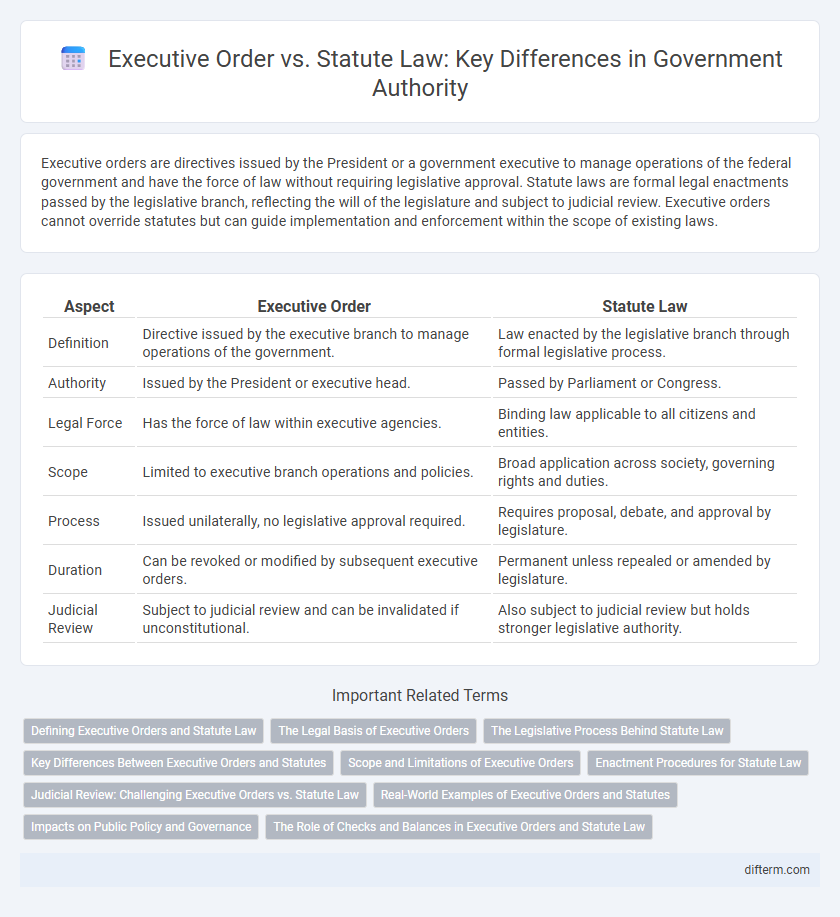Executive orders are directives issued by the President or a government executive to manage operations of the federal government and have the force of law without requiring legislative approval. Statute laws are formal legal enactments passed by the legislative branch, reflecting the will of the legislature and subject to judicial review. Executive orders cannot override statutes but can guide implementation and enforcement within the scope of existing laws.
Table of Comparison
| Aspect | Executive Order | Statute Law |
|---|---|---|
| Definition | Directive issued by the executive branch to manage operations of the government. | Law enacted by the legislative branch through formal legislative process. |
| Authority | Issued by the President or executive head. | Passed by Parliament or Congress. |
| Legal Force | Has the force of law within executive agencies. | Binding law applicable to all citizens and entities. |
| Scope | Limited to executive branch operations and policies. | Broad application across society, governing rights and duties. |
| Process | Issued unilaterally, no legislative approval required. | Requires proposal, debate, and approval by legislature. |
| Duration | Can be revoked or modified by subsequent executive orders. | Permanent unless repealed or amended by legislature. |
| Judicial Review | Subject to judicial review and can be invalidated if unconstitutional. | Also subject to judicial review but holds stronger legislative authority. |
Defining Executive Orders and Statute Law
Executive orders are directives issued by the President or executive branch officials that manage operations of the federal government without requiring legislative approval. Statute law consists of laws enacted by legislatures, such as Congress, and codified into formal legal codes. While executive orders control administrative actions, statute laws establish binding legal standards with broader authority and permanence.
The Legal Basis of Executive Orders
Executive orders derive their legal basis from the Constitution and statutory provisions granting authority to the President or executive agencies, enabling them to manage federal government operations. Unlike statute law, which is enacted by the legislative branch and requires congressional approval, executive orders have the force of law but are limited to the scope of existing statutes and constitutional powers. Courts can review executive orders to ensure they do not exceed the executive's authority or conflict with statutory law.
The Legislative Process Behind Statute Law
Statute law results from a comprehensive legislative process involving proposal, committee review, debates, and formal voting within the legislative body. This process ensures thorough scrutiny and democratic legitimacy before a statute becomes law, distinguishing it from executive orders, which are issued unilaterally by the executive branch. Unlike executive orders, statutes require approval by elected representatives and often include multiple stages of revision and public input.
Key Differences Between Executive Orders and Statutes
Executive orders are directives issued by the President or a governor to manage operations of the executive branch, while statutes are laws enacted by the legislature and signed by the executive. Executive orders have immediate effect but can be overturned by legislation or judicial review, whereas statutes have broader applicability and stronger legal authority. Statutes provide a permanent legal framework, whereas executive orders are typically limited in scope and duration to specific administrative purposes.
Scope and Limitations of Executive Orders
Executive orders derive authority from the Constitution or statutes and primarily direct government operations within the executive branch, enabling swift policy implementation without legislative approval. Their scope is limited by existing laws and the Constitution, preventing them from creating new laws or appropriating funds, which remain the prerogative of Congress. Courts regularly review executive orders to ensure they do not exceed presidential authority or infringe upon individual rights established by statute or constitutional protections.
Enactment Procedures for Statute Law
Statute law requires a formal legislative process involving proposal, committee review, debate, and approval by both legislative chambers before receiving executive assent to become law. Enactment procedures include multiple readings, public consultations, and possible amendments to ensure legal validity and democratic legitimacy. This structured process distinguishes statute law from executive orders, which are issued unilaterally by the executive branch without legislative approval.
Judicial Review: Challenging Executive Orders vs. Statute Law
Judicial review distinguishes executive orders and statute law by evaluating their compliance with constitutional principles and statutory authority. Executive orders face scrutiny to determine whether they exceed presidential powers or conflict with existing laws, often resulting in courts voiding those found unlawful. In contrast, statute laws undergo review for constitutional validity but are generally upheld unless they infringe on fundamental rights or constitutional mandates.
Real-World Examples of Executive Orders and Statutes
Executive orders, such as President Franklin D. Roosevelt's Executive Order 9066, which authorized Japanese American internment during World War II, demonstrate the executive branch's power to address immediate national concerns. In contrast, statute laws like the Civil Rights Act of 1964, enacted by Congress, provide long-term legal frameworks that require legislative approval and often result in broader societal changes. These examples highlight how executive orders can swiftly implement policy within existing legal boundaries, while statutes establish enduring legal standards through a democratic process.
Impacts on Public Policy and Governance
Executive orders enable swift policy implementation by allowing the executive branch to act without legislative approval, directly influencing governance through rapid response to emerging issues. Statute laws, enacted by the legislature, establish long-term legal frameworks that provide stability and consistency in public policy. The interplay between executive orders and statutes shapes governance dynamics, balancing flexibility with democratic oversight in policy formulation and execution.
The Role of Checks and Balances in Executive Orders and Statute Law
Executive orders and statute laws operate under a system of checks and balances designed to prevent the abuse of power within the government. Executive orders, issued by the President, must comply with existing statutes and are subject to judicial review by courts to ensure constitutional adherence. Statutes, enacted by Congress, hold legislative supremacy but can be challenged or limited by executive enforcement discretion and judicial interpretation.
executive order vs statute law Infographic

 difterm.com
difterm.com